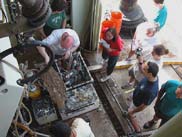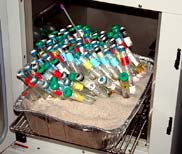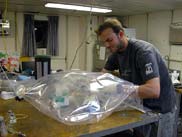|
|
|||||||||||||||||||||||||||||||||||||||||||||||||||||||||||||||||||||||||||||||||||||||||||||||||||
 |
|||||||||||||||||||||||||||||||||||||||||||||||||||||||||||||||||||||||||||||||||||||||||||||||||||
I like weird stuff. Especially if it’s weird biological stuff. Aliens, for example, would be very weird biological stuff. Unfortunately, there is a shortage of aliens available for graduate students like me to study, so instead I am doing thenext best thing: searching for weird life forms in a weird environment on Earth that nobody has ever studied before – the Lost City.
So how do you go about searching for new, weird life forms? The first step is to take Alvin down to the Lost City and collect rocks and water samples. When Alvin comes back to the ship, there is a feeding frenzy of scientists trying to grab the samples that they need for their research. Sometimes it’s important to get your samples as quickly as possible before they degrade or become contaminated, so this is the best time to see scientists hurrying to sample and process the rocks--sometimes it can get a little hectic. The weirdest organisms are always the microorganisms – the bacteria and archaea - so that’s what I’m looking for in the precious samples allowed to me. Most of the work that Mausmi Mehta and I are doing during the cruise involves adding rocks and water samples to small tubes containing nutrients.
We’re hoping that the nutrients will encourage microorganisms from the Lost City to grow inside the tube, but this has been problematic because we have no idea what nutrients the Lost City microbes will need. We don’t know what they like to eat. They might eat pizza and peanut butter like we do, but there doesn’t seem to be much pizza or peanut butter in the Lost City, so any life there must be eating something else. Microbes in other hydrothermal vents are known to eat iron, sulfur, carbon dioxide, or even hydrogen sulfide (that’s what causes the smell of rotten eggs). If we tried to eat that stuff, we would die. The chemists say that there is an unusual amount of methane gas at Lost City, so we think there might be organisms excreting or eating methane there. But we really have no idea, so I’m trying pretty much everything – I’ve tried at least 100 different nutrient combinations so far. It’s still too early to know how successful we’ve been at finding the right food, but we do know that Lost City microbes like to grow at 90° C (that’s 194° F, almost the boiling point of water). If I put them at anything less than that, they stop growing. When we notice that something might be growing in the tubes, we look at it under the microscope, but it’s hard to identify microbes with a microscope.
Unless the microscope is very powerful (not the kind you bring on a boat), they all look like black specks. So when we get back to land, we will extract DNA from all of the samples we’ve collected. This DNA will be from all of the organisms in that part of the environment, even the species that didn’t like my nutrient tubes. After we determine the sequence of this DNA, we will be able to say which species are at the Lost City - and whether any of them are new, weird discoveries. Working with samples in an anaerobic glove bag. Microbes from the Lost City will die if they're exposed to oxygen, so we have to handle them inside this bubble that keeps oxygen out. The culture tubes are sealed to make sure oxygen can't leak in. |
|||||||||||||||||||||||||||||||||||||||||||||||||||||||||||||||||||||||||||||||||||||||||||||||||||



